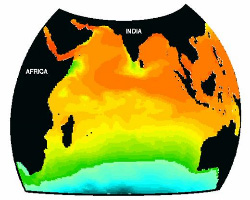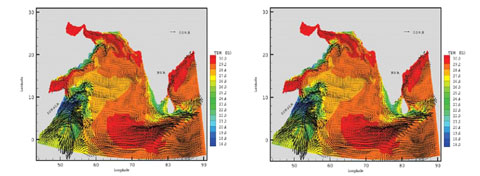Research & Development Areas
Our Core R&D Areas Include:
Monsoon and ocean variability, Climate Change, Sea level variations
Introduction
The oceans which occupy 63% of the surface area of the tropics influence the climate of this region in a variety of spatial and temporal scales. The water vapour present in the atmosphere is controlled by the evaporation from the oceans and the winds are determined by the heat released by precipitation and the winds control the oceanic circulation and evaporation.
The annual heating/cooling of the Asian continent, the meridional gradient of tropospheric heating and the associated monsoon circulation are the most important aspects of atmospheric circulation. Almost half of the world's population live in areas affected by the Asian summer monsoon, and even slight deviations from the normal monsoon pattern can have great impact on agricultural production, water availability and hydroelectric power generation to name a few. Against the backdrop of rising global surface temperature, the stability of the monsoon rainfall remains to be a puzzle to the scientific community.
The Asian monsoon influences the currents in the North Indian Ocean, while the atmosphere's anticyclonic circulation influences the circulation in the South Indian Ocean. Recently, the Indian Ocean has been discovered to have a much larger impact on climate variability than what previously thought of. Changing winds and currents in the Indian Ocean during the 1990s have contributed to the observed warming of the ocean during this period. Understanding the cause of this warming and predicting its future evolution are major challenges to the scientific community, as the ocean warming is tied into a much larger global cycle of events. Also the warming of the Indian Ocean has impact on the North Atlantic Oscillation(NAO) through teleconnection between the low and high latitudes. Synoptic observations of the oceans are available through satellite data and the deployment of moored buoys in the oceans enable near real-time monitoring of the oceanic processes and NERCI''s approach to this field of research is with the following ;
Objectives
- To understand monsoon variability on all time and spatial scales and its relation to ocean.
- To improve the understanding of climatic teleconnections between the higher latitudes and the tropics.
- Tropical Indian and Pacific ocean will be the focal area of study.
Approach
Mainly coordinated with the research collaboration with the Ocean modelling group of the Nansen Centres and other MoU partners through implementation and application of numerical ocean and atmospheric models with insitu data and satellite observations.
Numerical Ocean Modelling
a) Large-scale Ocean Modeling A version of physical ocean model MICOM is in operation to understand and simulate the circulation in the Indian Ocean . The model has a resolution of 40km with finer resolution towards the northern Indian Ocean . The model are forced with the available meteorological data.
 The domain of the large-scale oceanographic model (here show sea surface temperature - SST) implemented at the Nansen Center in Norway for the Indian Ocean region.
The domain of the large-scale oceanographic model (here show sea surface temperature - SST) implemented at the Nansen Center in Norway for the Indian Ocean region.
Coastal Modeling
For understanding the coastal features of the ocean circulation a finer scale model is necessary. A nested version of MICOM model now improved with HYCOM with currently a resolution of 11km has been implemented. The coastal currents on either side of the Indian sub-continent with it's seasonal reversal and spatial variability are simulated using this model. The simulated feature of circulation are enhanced assimilating satellite radar altimetry and sea surface temperature (AVHRR) data into the model.

Sea surface Temperature and sea surface current vectors of 1 st July, 1996 ( Miami Iso-picnic Ocean Model- MICOM now improved with HYCOM) The role of the oceans in the global climate system has been well-established and NERCI's research aims to advance our understanding of the feedback mechanisms between oceanic variability and climate change. NERCI has access to a range of numerical ocean models capable of simulating and predicting ocean parameters such as current velocities, temperature, salinity, density, nutrients and biological productivity. These models are implemented at regional and global scales and used to study ocean features such as the large-scale circulation, mesoscale variability, thermal structures, wave motions and instabilities. Ecosystem dynamics and chemistry have been coupled to the physical models, enabling them to simulate the seasonal cycling of carbon and nutrients, including the net exchange of CO2 across the air-sea interface and the seasonal variations in planktonic productivity. Global sea level data from several satellite radar altimeter missions are also analysed and assimilated in numerical models to provide optimal simulations of ocean circulation.
OCEAN COLOUR GROUP IN THE NANSEN CENTRE
Name |
Designation |
Institute |
Contact information |
|
1 |
Prof.P.V.Joseph |
Associate Leading Scientist |
NERCI |
joporathur@gmail.com |
2. |
Jayakumar.A |
Scientist |
NERCI |
jayamet@gmail.com |
3. |
Prof.Ola M.Johannessen |
Founding Director |
NERSC/NERCI |
Ola.johannessen@nersc.no |
4. |
Dr.Laurent Bertino |
Research Director |
MSC-NERSC |
Laurent.bertino@nersc.no |
5. |
Ms. Mary Swapna George |
Ph.D student |
NERSC/NERCI |
Sapnageorge.k@gmail.com |
Key Personnels at NERCI
Prof. P.V.Joseph (Associated Scientist and Group Head)
Prof. Ola M. Johannessen, Associate Scientist
A.Jayakumar, Scientist
Mary Swapna George (Ph.D student at NERSC, Bergen)
Dr. K. Ajith Joseph (Sr. Scientist)


